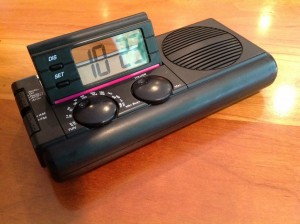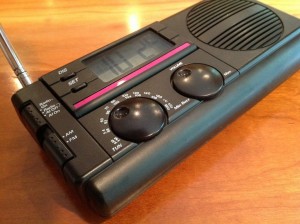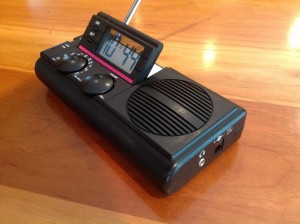Last time I noticed a used RFSpace NetSDR at Universal Radio, it was snatched up in a matter of moments.
Monthly Archives: August 2013
All Night Flight: Weiskopf takes us on an audio journey
 I’m a big fan of practically anything that Myke Dodge Weiskopf produces.
I’m a big fan of practically anything that Myke Dodge Weiskopf produces.
We’ve mentioned Myke numerous times on the SWLing Post; based in Los Angeles, California, he’s a radio producer, historian, broadcast artist, multi-instrumentalist, sound recordist, and composer.
Recently, I noticed that one of Myke’s audio mixes, ALL NIGHT FLIGHT, was featured on the über-cool experimental radio broadcast platform, Radius.
In Myke’s artist statement on Radius, he describes this mix simply:
This edition, produced exclusively for Radius, is a 73-minute distillation of the inaugural «ALL NIGHT FLIGHT» performed, created, and mixed live by Myke Dodge Weiskopf in the desert of Joshua Tree, California, on 20 July 2013, 10 PM – 5 AM PST.
I have embedded this mix below, but encourage you to check out Radius for his detailed mix description and Myke’s homepage for details on ALL NIGHT FLIGHT and his other interesting projects.
So, go ahead: put on your headphones, relax in your listening chair, and let Myke take you on an audio journey…
Paul reviews the mystery radio
Many thanks to Paul for providing this review of his mystery radio (see previous posts):
 This is a basic AM/FM radio with clock and alarm functions. It runs off three AA batteries (for the radio) or a 1.5 V small cell battery (for the clock). There is also the option of powering it with an AC adapter (4.5 V DC, center positive). The speaker is 8 ohm, 0.5 W. As Ulli pointed out the three AA batteries are a very tight fit. Besides radio and alarm, there is also a headphone jack.
This is a basic AM/FM radio with clock and alarm functions. It runs off three AA batteries (for the radio) or a 1.5 V small cell battery (for the clock). There is also the option of powering it with an AC adapter (4.5 V DC, center positive). The speaker is 8 ohm, 0.5 W. As Ulli pointed out the three AA batteries are a very tight fit. Besides radio and alarm, there is also a headphone jack.
The SET and DIS buttons on the radio are for setting the clock and alarm. In absence of a manual it took a little time to figure out how to do this. The clock LCD tilts up as shown in the photos. Needless to say the viewing angles leave much to be desired. This radio is meant to be used laying on a table; it has a curved bottom and cannot stand up on its own.
 In terms of performance, it’s good for powerhouse AM and FM stations. DXing is very limited or next to impossible due to the stiff tuning knob (you need two fingers to move it around; the dimple is not helpful) and the short circular tuning range. It’s hard to tell whether the radio has below average built-in selectivity with the Sony CXA1191S chip, or are problems zeroing in on stations due to the poorly designed knob. In my unit the volume knob was scratchy; this was easily fixed with a little DeoxIt spray.
In terms of performance, it’s good for powerhouse AM and FM stations. DXing is very limited or next to impossible due to the stiff tuning knob (you need two fingers to move it around; the dimple is not helpful) and the short circular tuning range. It’s hard to tell whether the radio has below average built-in selectivity with the Sony CXA1191S chip, or are problems zeroing in on stations due to the poorly designed knob. In my unit the volume knob was scratchy; this was easily fixed with a little DeoxIt spray.
 Among other curious things about this radio is its antenna, which goes out only at a fixed angle – not straight up. It can be moved from left to right at this angle and extended.
Among other curious things about this radio is its antenna, which goes out only at a fixed angle – not straight up. It can be moved from left to right at this angle and extended.
Overall this is a basic AM FM clock radio, measuring small (6.25 x 3 x 1.25 inches), and honestly, nothing really special!
Paul, thanks for the review and great photos of your radio. It might not be a performance machine, but it was fun solving the mystery and reading your review of this obscure little radio! -Thomas
VOA Radiogram 3-4 August includes MFSK and EasyPal
 (Source: VOA Radiogram)
(Source: VOA Radiogram)
If you are an EasyPal fan, EasyPal returns this weekend with a striking image of the Las Vegas skyline. Don’t be too disappointed if you cannot decode the EasyPal image. A certain signal threshold is required, and the failure rate is rather high.
In recording the program for this weekend, I applied audio compression to my voice introduction and to the music at the end of the show — but not to the digital tones. Perhaps you will notice the difference.
Here is the lineup for VOA Radiogram for the weekend of 3 and 4 August 2013:
2:30 MFSK16: Program preview
:45 MFSK32: VOA logo image
5:22 MFSK32: VOA News re 3D printed heart
1:00 MFSK32: Heart image
4:15 MFSK64 in Flmsg* format: VOA News re oxygen in Mars’s past
1:15 MFSK32: Mars image
7:05 EasyPal image** (4-QAM)
1:08 MFSK16: closing announcements
1:17 MFSK32: VOA Radiogram logo image
:55 Surprise mode of the week*To make Flmsg work with Fldigi (both can be downloaded from w1hkj.com), in Flmsg: Configure > Misc > NBEMS — Under Reception of flmsg files, check both boxes, and under that indicate where your Flmsg.exe file is located.
**Download EasyPal software from vk4aes.com.
Please send reception reports to [email protected]
These would be especially helpful:
1) Audio samples of poor reception which nevertheless results in a successful decoding of the text modes.
2) Reception of the digital modes on less expensive portable radios, and any advice you have on how to feed audio from those radios to your PC and the decoding software.
VOA Radiogram transmission schedule
(all days and times UTC)
Sat 1600-1630 17860 kHz
Sun 0230-0300 5745 kHz
Sun 1300-1330 6095 kHz
Sun 1930-2000 15670 kHz
All via the Edward R. Murrow transmitting station in North CarolinaThanks for listening and decoding.
“You are listening to the Free Hellenic Radio”
 Yesterday was the first day in nearly a month that I had turned on my SDR to record broadcasts. Between my travel schedule, getting the PC fixed, and near-constant summer thunderstorms, my SWLing has been limited to portables and sporadic travel listening. It felt so great yesterday to turn on the WinRadio Excalibur and do a little band-scanning. As I skimmed across the bands, I checked in with my good friend, the Voice of Greece, on 9,420 kHz. And, as I listened, I flipped on the “record” switch.
Yesterday was the first day in nearly a month that I had turned on my SDR to record broadcasts. Between my travel schedule, getting the PC fixed, and near-constant summer thunderstorms, my SWLing has been limited to portables and sporadic travel listening. It felt so great yesterday to turn on the WinRadio Excalibur and do a little band-scanning. As I skimmed across the bands, I checked in with my good friend, the Voice of Greece, on 9,420 kHz. And, as I listened, I flipped on the “record” switch.
What I recorded was more than three hours of uninterrupted Greek music. Click hear to download the full recording, or listen via the embedded player below:
Three hours of music with no commentary (save a little dead air) is certainly not a typical format for the Voice of Greece, so I took note. If you’ve been reading The SWLing Post for long you’ll know that the Voice of Greece and its domestic broadcasting counterparts have been going through a major shake-up. In the wake of the government closure of ERT on June 11th, within hours, former ERT journalists defiantly got back on the air. Until courts ordered the immediate re-opening of the Greek national broadcaster, the Voice of Greece was, in a sense, a very powerful pirate radio broadcaster. Interestingly, since the shakeup in June, I learned that the Voice of Greece has barely been off-air.
Since I don’t speak or understand Greek, and since they’ve only made a few public statements in English, I turned to my friend and SWLing Post reader/contributor, Christos, for details. He writes:
I will try to describe…the current situation regarding the ERT issue, I hope in an objective way.
…[I]n front of the Radio House in Aghia Paraskevi suburb…all the fence[s] and part of the building [are] covered by banners. Almost every [evening], concerts take place in the yard. The participant artists express their solidarity [with] those who run the ERT since 11 of June, when the government fired 2,650 employees in order to recruit some 2000 again.
The so-called occupiers of the Radio House demonstrate signs of [fatigue] as less producers and known journalists appear in the programmes. Their programme is transmitted from medium waves 729, 1008, 1260 1404 and 1512 KHz…enough to cover the whole country during night time. I checked the short wave frequency of 9420 KHz; they [host] a different musical programme…the one you receive in [the US] [hear this above]. I think that this is a dead end for those who continue, as 3,000 people in the media business have applied for job[s] in the new ERT. The vice minister responsible…will recruit only 500 of them…
Two days ago, we had a night of tension as some protesters appeared on the mountain where the antennas are located…[P]olice arrested some of them.
You can get an idea of this incident [by] watching the following two videos:
Another source of [information about] the ERT occupiers is:
http://www.ertopen.com/news-in-4-languges/english
…[T]here have not been announcements about the future of the Voice of Greece. Think that some 10 million…Greeks live in the country, and some 10 [million] more [live] abroad.
[The pace of] Greek summer…[is] slow. People go to the beaches or to their native villages. Everybody looks exhausted as the last two days the temperature reached 39 degrees Celsius which is 102.2 degrees Fahrenheit. Today the SKAI, one of the biggest private radio stations, fired 10 journalists add[ing] to [the] 50 [previously fired]. Now they repeat older programmes and there [is] no news broadcasted.
Remaining journalists in ERT refer to [the broadcasting service] as: Hellenic Radio – The Voice of Freedom, and often announce, “You are listening to the Free Hellenic Radio.”
Once again…giving you an idea [of the political] climate here…this morning the government announced the names of 2,122 teachers – public servants from technical education [–] who lost their job[s].
I hope this will be of…interest.
Christos, we thank you so much for your insight and opinions about the state of Greek national and international broadcasting! We at The SWLing Post support freedom of press in Greece, and commiserate with those who have lost their jobs, especially in such an oppressively hot summer. Please do continue to keep us informed.
I have sincere doubts about the longevity of the Voice of Greece (or Free Hellenic Radio) on shortwave. With the serious budget cuts the new ERT must be built on, I doubt they’ll consider funding shortwave radio in Greece. I feel like it may only be a matter of time before we lose yet another shortwave broadcaster. I certainly hope I’m wrong…
In the meantime, I’ll be dedicating more hard drive space to spectrum recordings of VOG.

